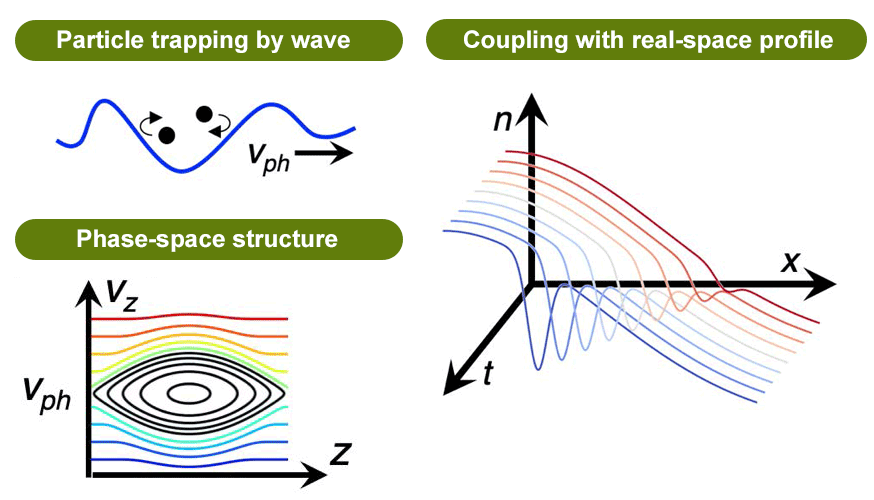Latest News
News List-
Research Summary
In this unit, motivated by the anomalous transport problem in magnetically confined fusion plasmas, formulation of nonlinear wave-particle interaction in turbulent field is advanced. In high-temperature and low-collision fusion plasmas, particles are trapped in a phase of wave by which the wave potential is nonlinearly evolved and a structure forms in the phase-space (Fig. 1 left). The phase-space structure can couple with the real space plasma profile, by which a free energy is released and the phase-space structure grows (Fig. 1 right) [1]. Stochastic overlapping and cascade of the phase-space structures are also possible, resulting in emergence of the so-called phase-space turbulence. Phase-space turbulence is considered to play a role for driving anomalous transport in high temperature plasmas, involving enigmatic transport features, e.g., nondiffusivity, nonlocality, subcriticality, and others [2]. According to those theoretical predictions, survey for possible phase-space structures and examination of their contribution on plasma transport are experimentally conducted in this unit. In velocity distribution function measurement with a sufficiently high resolution, it is necessary to spread signal into the velocity dimension, which lowers the signal intensity at a single detector bin. In other words, signal intensity and measurement resolution are in a trade-off relation, which makes phase-space turbulence detection challenging.

Figure 1. Overview of phase-space structure formation. This unit attempts to overcome those difficulties by utilizing cutting-edge velocity space diagnostic systems recently being developed [3]. Perspective view of phase-space structures provided by state-of-the-art kinetic plasma simulation strongly helps optimization of diagnostic systems in surveying target turbulent phenomena. Electron scale phase-space structures are known to emerge in low-temperature and low-density basic devices, such as Q-machine, and experimental demonstration of those structures were performed previously [4]. Revisiting those classical phase-space experiments with aids of present-day diagnostic and simulation technics propel basic understanding of phase-space turbulence physics. Phase-space structure formation is a general phenomenon in collisionless plasmas, and is known to occur in systems other than magnetically confined fusion plasmas. Nonlinear characteristics vary in different plasma systems, therefore comparing different cases is beneficial for a general understanding of the phase-space structure formation. For example, phase-space plasma dynamics in the laser wake-field plasma acceleration field [5] or the magnetospheric plasmas [6] is known to be important.
- P. W. Terry, P. H. Diamond, and T. S. Hahm, “The structure and dynamics of electrostatic and magnetostatic drift holes“, Physics of Fluids B: Plasma Physics 2 (1990) 2048.
- Y. Kosuga, S.-I. Itoh, P. H. Diamond, K. Itoh, and M. Lesur, “Role of phase space structures in collisionless drift wave turbulence and impact on transport modeling“, Nuclear Fusion 57 (2017) 072006.
- K. Ida, T. Kobayashi, M. Yoshinuma, K. Nagaoka, K. Ogawa, T. Tokuzawa, H. Nuga, and Y. Katoh, Communications Physics (2022), in press .
- K. Saeki, P. Michelsen, H. L. Pécseli, and J. J. Rasmussen, “Formation and Coalescence of Electron Solitary Holes“, Physical Review Letters 42 (1979) 501.
- T. Tajima and J.M. Dawson, “Laser Electron Accelerator“, Physical Review Letters 43 (1979) 267.
- N. Kitamura, M. Kitahara, M. Shoji, Y. Miyoshi, H. Hasegawa, S. Nakamura, Y. Katoh, Y. Saito, S. Yokota, D. J. Gershman, et. al., “Direct measurements of two-way wave-particle energy transfer in a collisionless space plasma“, Science 361 (2018) 1000.
Member
*:Unit Leader
-
Guest Prof. EBIHARA, YusukeAffiliate Kyoto University
-
Project Prof. FUJISAWA, AkihideFields Plasma physicsAffiliate Kyushu University
-
Project Prof. IDA, KatsumiFields Plasma physics
-
Assoc. Prof. KENMOCHI, NaokiFields Plasma physics
-
Assoc. Prof. KOBAYASHI, TatsuyaFields Plasma physics
-
Project Researcher NASU, Tatsuhiro
-
COE Researcher NISHIMURA, Daiki
-
Assoc. Prof. NISHIURA, Masaki (Chairperson)Fields Plasma physics
-
Guest Assoc. Prof. SASAKI, MakotoAffiliate Japan University
-
Prof. TOKUZAWA, Tokihiko (Unit Leader)Fields Plasma physics
-
COE Researcher UEDA, Kenji
-
Assoc. Prof. YAMADA, IchihiroFields Plasma physics
-
Assist. Prof. YANAI, RyohmaFields Plasma physics
-
Assist. Prof. YOSHINUMA, MikiroFields Plasma physics
External Member
-
EBIHARA, YusukeAffiliate Kyoto University, Prof.
-
EJIRI, AkiraAffiliate Tokyo University, Prof.
-
FUJISAWA, AkihideAffiliate Kyushu University, Prof.
-
IWAMOTO, MasanoriAffiliate Kobe University, Project Assist. Prof.
-
KAWACHI, YuichiAffiliate Nagoya University, Assist. Prof.
-
KAWAZURA, YoheiAffiliate Utsunomiya University, Assoc. Prof.
-
KIN, FumiyoshiAffiliate Kyoto University, Assist. Prof.
-
NISHIZAWA, TakashiAffiliate Kyushu University, Assist. Prof.
-
NUMATA, RyusukeAffiliate University of Hyogo, Prof.
-
SASAKI, MakotoAffiliate Japan University, Assoc. Prof.
-
TANABE, HiroshiAffiliate Tokyo University, Assoc. Prof.
Publications
Contact
Email:staff_pst

